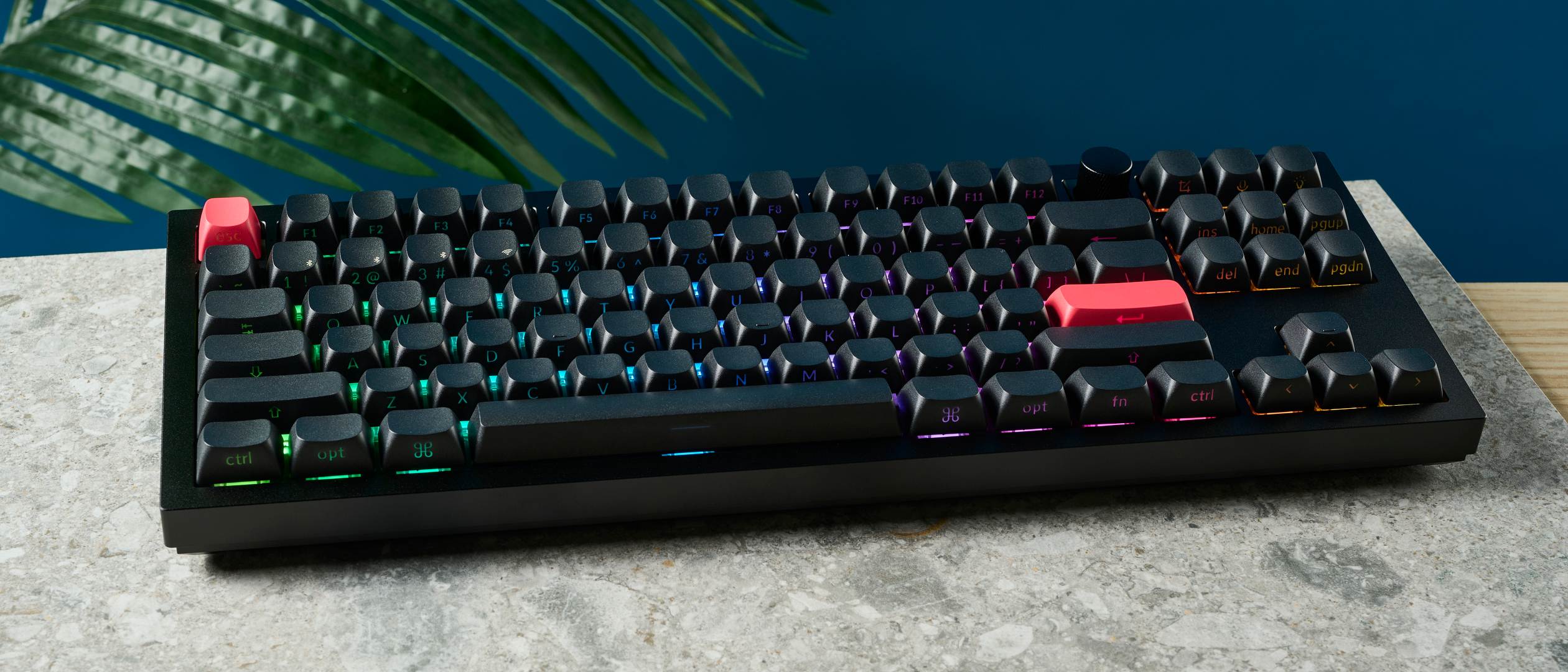Tom's Guide Verdict
A gorgeous keyboard, either in the retro or stealth fighter styles available. Encased entirely in metal and acoustically damped to oblivion, the Q3 Max sounds epic and won’t give you any headaches in the build quality department. 1,000Hz polling also makes it a suitable gaming board if you so desire. Unfortunately, it’s expensive, rather heavy, and the lack of height adjustability might have you considering other options.
Pros
- +
Gorgeous
- +
Sounds incredible
- +
Lovely to type on
- +
Supreme build
- +
1,000Hz polling
Cons
- -
Expensive
- -
Heavy
- -
No height adjustment
Why you can trust Tom's Guide
The Keychron Q3 Max is a metal-clad productivity keyboard from a manufacturer which has produced some of the best mechanical keyboards in recent years, often at very affordable prices.
The Q3 Max lives up to half of that legacy. This metalized version of the Keychron V3 80% TKL is doubtless a fantastic mechanical keyboard, offering an epic build, stunning looks (especially with optional side-printed keycaps), beautiful sound and a flawless typing experience.
The thing that’s missing is the “affordable” bit. This keyboard costs $214 from Keychron and even more from Amazon, so it’s far from cheap. If you can afford it, you’ll not be disappointed, although there are also a couple of things to consider which might give you pause for thought before you take the leap.
Find out more in our full Keychron Q3 Max review.
Keychron Q3 Max review: Cheat sheet
- What is it? A TKL 80% custom mechanical keyboard
- What does it cost? A lot: $214/ £209 from Keychron, $234 from Amazon
- Who is it for? Custom mechanical keyboard enthusiasts (with cash)
- What do we like? Its build, looks, sound and typing
- What don’t we like? Its price, weight and lack of height adjustment
Keychron Q3 Max review: Specs
| Price | $214 / £209 |
| Switches | Gateron Jupiter — Red/Brown/Banana |
| Hot swappable | Yes |
| Keycaps | Double-shot PBT (assembled) |
| Barebones option | Yes |
| Layout | 80% TKL, 87-keys |
| Stabilizers | Metal screw-in PCB |
| Mount type | Double gasket |
| Case material | Aluminum |
| Firmware | QMK open source |
| Operating systems | macOS/Windows/Linux |
| Paired devices max | 4 (Wireless) + 1 (Wired) |
| Battery | 4,000mAh |
| Battery life | ~3 weeks as tested |
| Polling rate | 1,000Hz (2.4G + Wired)/90Hz (Bluetooth) |
| Size | 14.4 x 5.4 x 1.3 inches |
| Weight | 4.5 lbs |
Keychron Q3 Max review: The ups
The Keychron Q3 Max looks great, especially with the side-printed black keycaps. It types wonderfully and is built well enough to serve as a load bearing construction beam, which results in a great sound, too.
Stealth fighter
We tested the Q3 Max with a black case, although it’s also available with an off-white case. Combined with the optional (at no extra fee) side-printed keycaps, I think it looks utterly fantastic, like the stealth fighter of keyboards. The side printed keycaps are also available to match the white case, and these have a more retro feel.
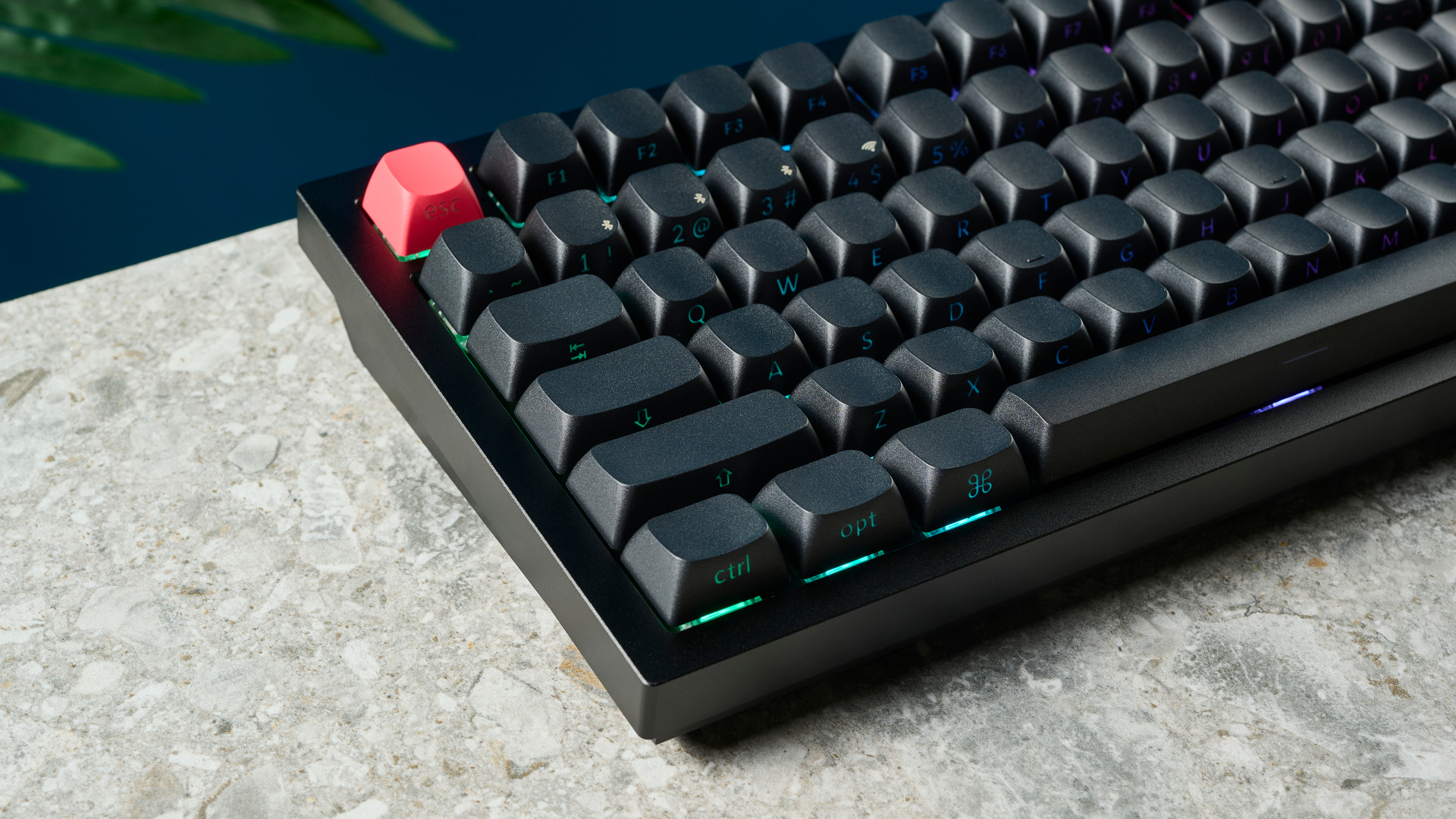
You can also spec top-printed keycaps if you’re not a confident touch typist. The side-printed keycaps are shine-through, so if you’re sitting back with a good posture, you should still be able to see the key emblems. Still, they aren’t the easiest to see, especially if you aren’t typing in the dark and so can’t see the RGB, which might take some getting used to.
Full Metal Jacket
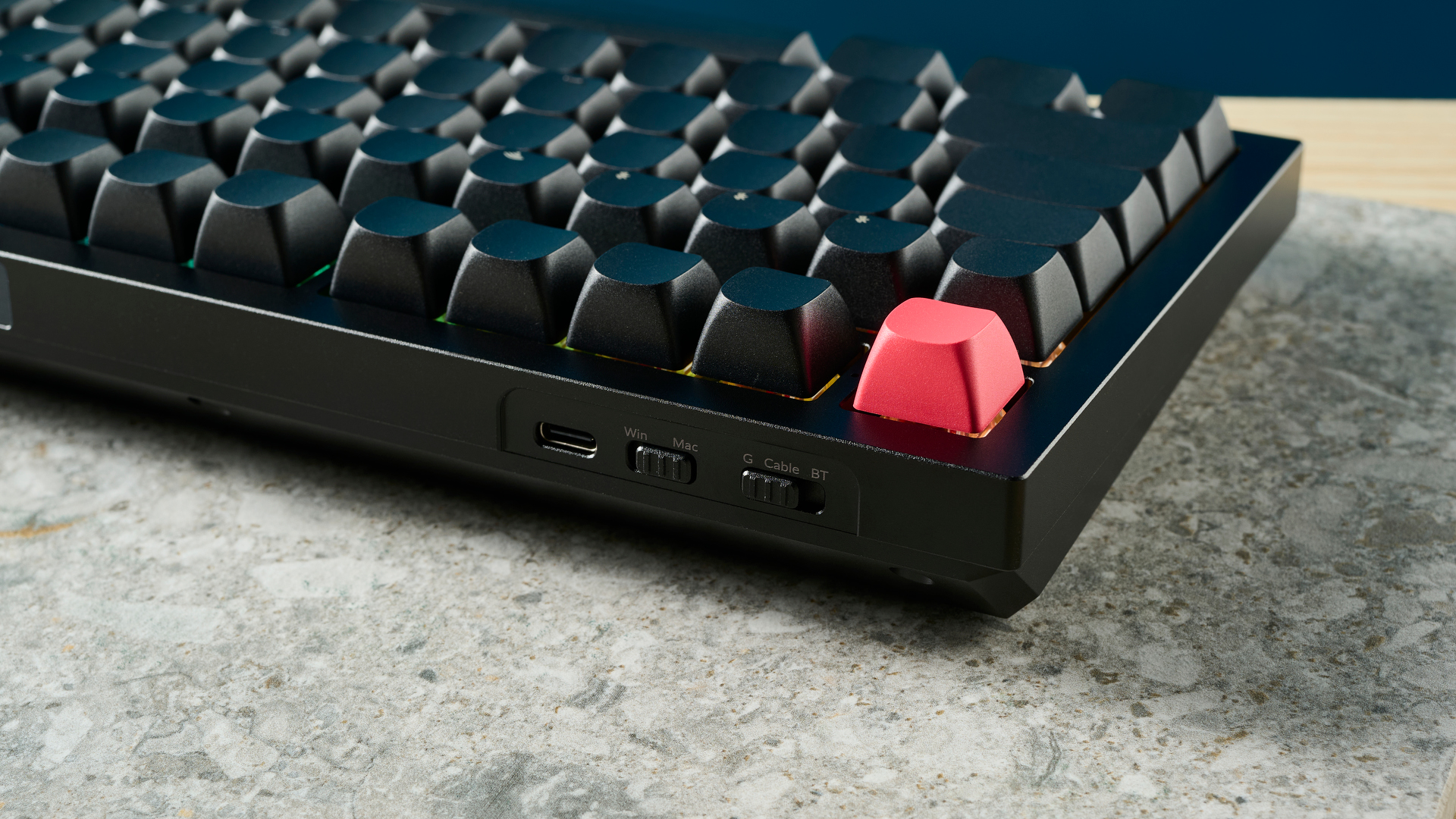
The Q3 Max is encased entirely in aluminum, just like the Keychron Q6 ($195). As such, the Q3 Max is an absolute beast, with absolutely no flex whatsoever — I’m pretty sure the construction industry could start using these as load-bearing beams.
This exemplary build quality extends throughout the board, too. Keycaps are double-shot PBT, so will stand up to heavy use; its stabilizers are metal screw-in resulting in no Space bar wobble; and the toggles and control knob offer firm satisfying feedback. The board comes with a high quality braided USB-C cable, too.
Clackety clack
Such impressive build quality also benefits the sound of the keyboard. Inside the case are seven layers of foam and silicone acoustic sound dampening — one more layer than the already incredibly damped and beautiful sounding NuPhy Halo75 V2 ($149) — plus double gasket mounts, resulting in a deep sound with no hollow sounds or rattles. This is aided, of course, by those heavy double-shot PBT caps.

Thankfully, Keychron has fitted the Q3 Max with a plastic rather than metal plate. The plate sits below the keycaps and is what they hit when pressed — a metal plate (as used in the Keychron Q6) results in a metal pinging sound that I’m not personally a fan of. The plastic plate used here sounds much better, and demonstrates a pleasing attention to acoustic detail from Keychron.
We tested the board with the Gateron Jupiter Red linear switches, which are very quiet, letting the board’s stellar inherent audial properties shine. I love the gentle, refined clack as the keycaps hit the plate. If you want to tinker with the board and customize its sound, it’s hot swappable, plus it ships with all the tools you need to take it apart. Keychron also sells the board with brown or banana tactile switches, if you want tactile feedback and a slightly louder sound.
Peak productivity
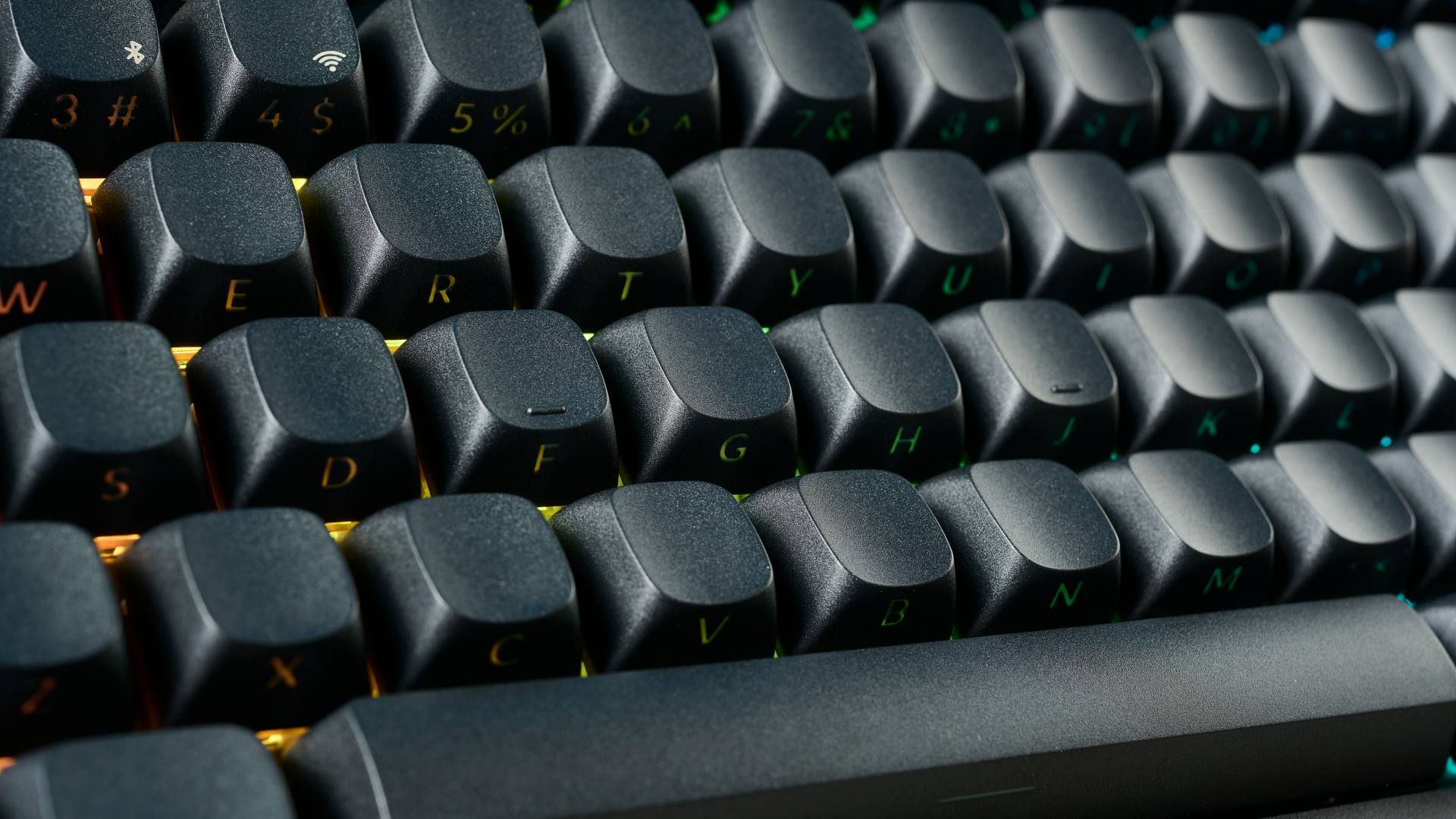
As with most Keychron boards, the Q3 Max’s box proudly claims that this board is designed for peak productivity. In this area, it doesn’t disappoint. It’s a lovely keyboard to type on. The doubleshot PBT keycaps are comfortable under the fingers and feature rounded edges to help minimize finger catches and mis-types during rapid use. However, they are quite tall when compared to other similarly priced productivity boards — in particular the NuPhy Gem80 ($199, after assembly), with its fantastic semi-low-profile mSA keycaps.
| Keyboard | Words per minute (WPM) | Typing accuracy |
|---|---|---|
| Keychron Q3 Max | 94 | 81.80% |
| Ducky One III TKL | 98 | 92.31% |
| NuPhy Gem80 (TKL) | 96 | 92.82% |
| NuPhy Halo75 V2 | 90 | 88.21% |
| Epomaker Dynatab 75 | 95 | 92.75% |
| Pete’s rolling averages (all keyboards) | 91.35 | 88.30% |
As you can see from the table above, I was hitting above average typing speeds, although my accuracy was around 7% below average, thanks to the relatively tall keycaps.
Whether you’re a Mac or Windows PC user, Keychron has you covered, with macOS keycaps fitted as default and Windows keycaps in the box. However, one thing I’d love to see Keychron begin implementing is dual-labelled keycaps, which are a productivity boon for people who switch between the platforms regularly, like me. Boards with dual labelled keycaps include the Lofree Block ($169), Lofree Flow84 ($159) and Logitech MX Mechanical Mini ($149).
Killer Hertz
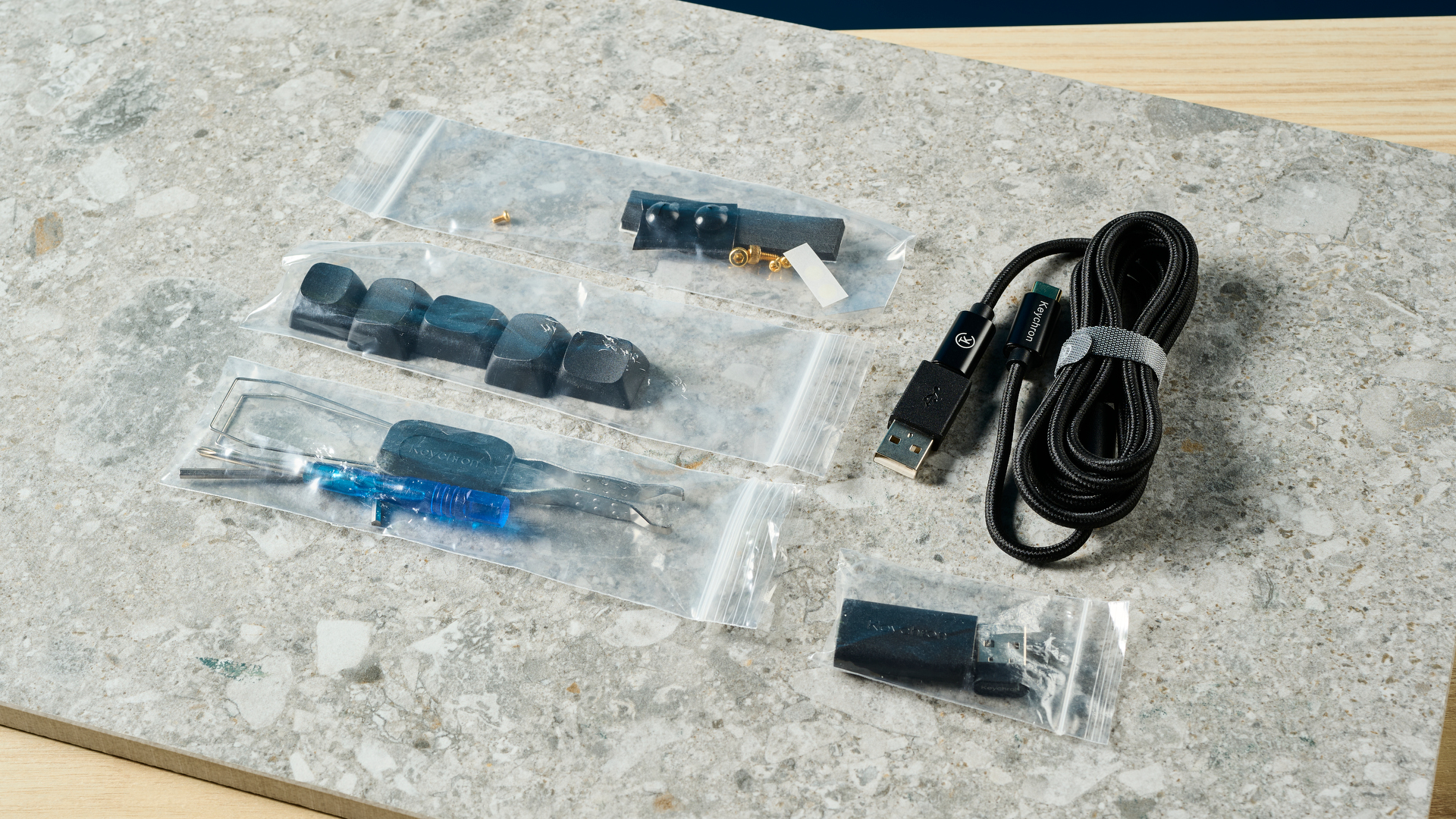
Over 2.4G and wired connections, the Q3 Max polls at 1,000Hz (this means it scans itself for inputs and reports those to the computer 1,000 times per second). This pales in comparison to the super high polling rates of the best gaming keyboards, like the Corsair K70 Max ($230) and its 8,000Hz polling, but should be fast enough to game on for most players.
Over Bluetooth, the Q3 Max’s polling drops to a sedate 90Hz, which will be fast enough for work and casual keyboard use, but not for fast-paced gaming.
Launcher life
The Keychron Q3 Max runs QMK firmware, just like many other boards we’ve reviewed, including the NuPhy Air75 V2 ($119) and Keychron V6 ($95). Keychron now offers the Keychron Launcher application for customzing, remapping and flashing the Q3 Max.
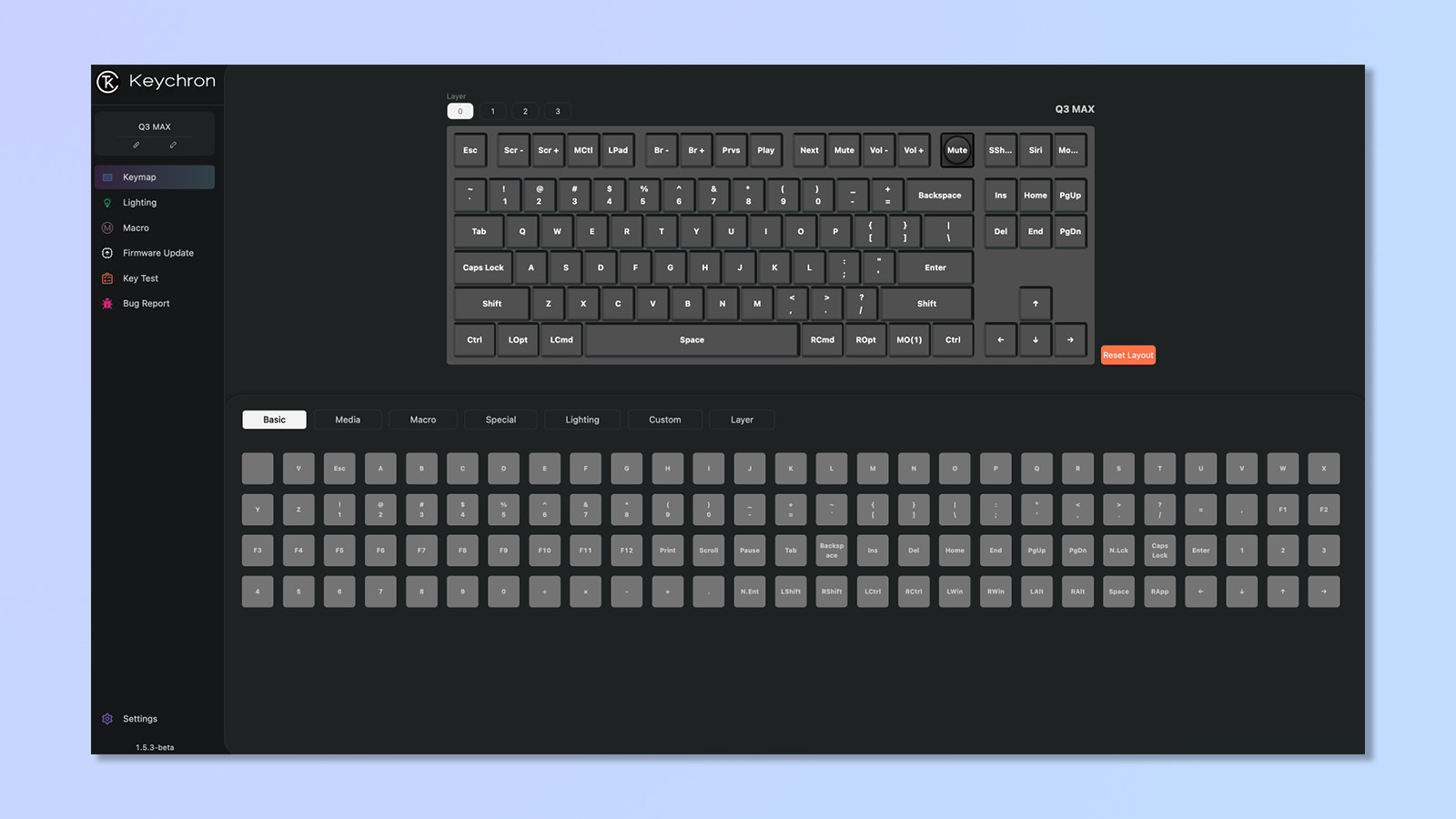
I much prefer this to the VIA software used for remapping NuPhy boards: Keychron launcher works on more browsers than just Chrome, yet still allows you to remap and customize your board completely. I was also able to quickly flash the Q3 Max’s firmware — my first flash wasn’t fully uploaded on my initial try, but it worked perfectly the second time around.
Keychron Q3 Max review: The downs
While it’s undoubtedly a beast, the Keychron Q3 Max isn’t perfect. Obviously, there’s the high price of $214, which may put it out of reach if you’re on a budget. It’s also heavy, while the lack of height adjustment might prove frustrating (and painful).
Better loosen the purse strings
My main point of contention with the Keychron Q3 Max is its price. This is kind of the going rate for high-end and highly customizable keyboards, as demonstrated by similar decks like the NuPhy Gem80 ($199). However, $214 is nevertheless a high price to pay.
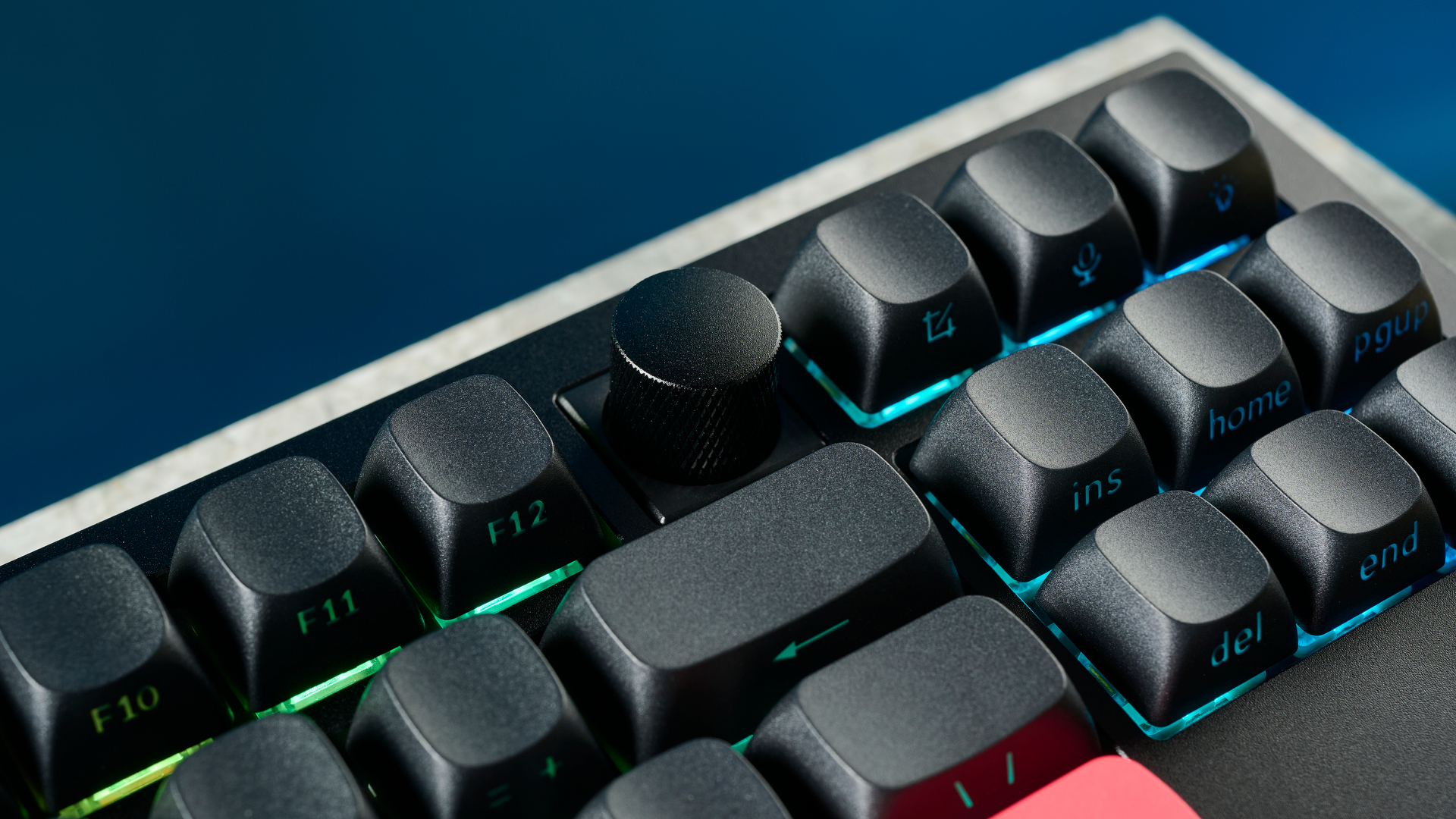
If you’re on a budget but want a moddable board, check out the Keychron V1/Max ($94), which gives you plenty of customization options for around half the price — it doesn’t come clad in plate armor like the Q3 Max, but is available in barebones format and can be taken apart just like the Q3 Max, so you can adjust internal acoustic dampening if you like.
Better hit the gym, too

Despite the benefits of a metal case outlined above, there’s no getting around the fact that the Keychron Q3 Max is a heavy beast. 72 ounces is very weighty for a TKL. If you’re in the mob, the Q3 Max will be perfect for weighing down your enemies as you chuck them into the Hudson. If you’re just an office worker like me, though, the Q3 Max won’t be one you’ll relish carrying in your backpack — it’s effectively a highly productive desk ornament that doesn’t suit being moved.
For a lighter and more portable mechanical keyboard, I’d recommend checking out the NuPhy Air75 V2 ($119) or the Gamakay LK75 ($119).
Oh, and better buy a wrist rest
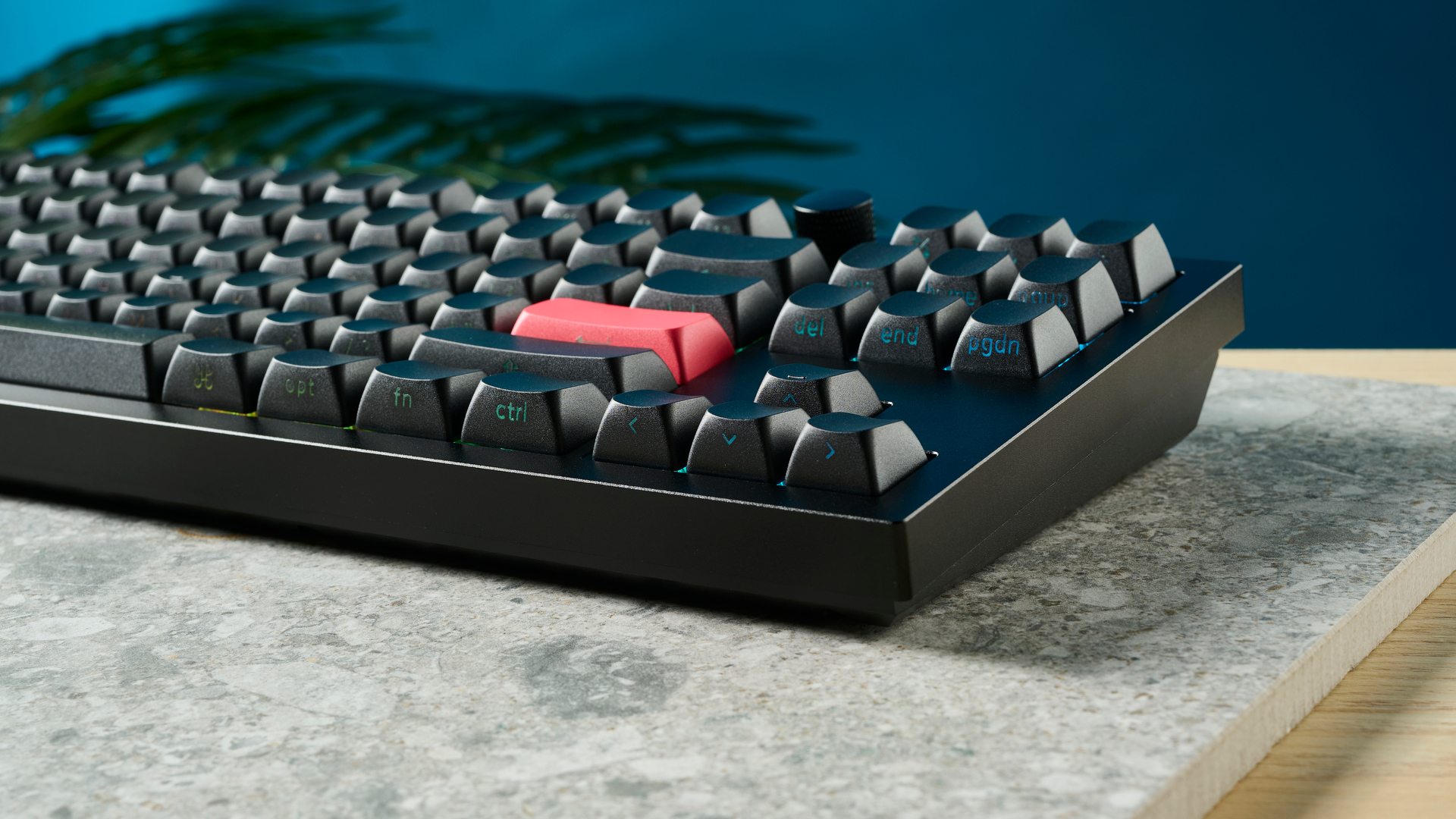
We test a lot of Keychron products, and there’s a common theme with their metal-based keyboards: they aren’t height adjustable. It isn’t that Keychron doesn’t appreciate the benefit of adjustable feet — their plastic-based boards like the V1 and V6 have them. Ostensibly, it seems that adding feet to the aluminum base is either too difficult or expensive for Keychron to do given their current manufacturing process.
The Q3 Max has a fairly good rake as it is, and I haven’t found it uncomfortable to use, but that may not be the case for everyone. I particularly missed a little extra height after switching back from testing the Lofree Block ($169), which has adjustable feet. You may need to factor in a wrist rest or look for a more adjustable board if you think it’ll be an issue.
Keychron Q3 Max review: Verdict

Highly customizable from the outset, and acoustically refined, the Q3 Max will be a perfect base for modders and keyboard enthusiasts. Its rival in that arena is the similarly-priced and highly customizable NuPhy Gem80. Which you pick will likely depend on aesthetic and audial taste, but for my money, I think the Keychron edges the NuPhy due to overall build quality and the more refined Keychron Launcher software.
I don’t think the Q3 Max is right for everyone, primarily due to its high cost, but if you have the cash and can get over its weight and lack of height adjustment, it’s undoubtedly an excellent purchase. The Q3 Max types beautifully with the Keychron caps and packs fast enough polling for all but the most competitive of gamers, so it isn’t just for custom keyboard enthusiasts and modders. And thanks to its aluminum plate armor, it’ll probably outlive your grandchildren, too.

Peter is Reviews Editor at Tom's Guide. As a writer, he covers topics including tech, photography, gaming, hardware, motoring and food & drink. Outside of work, he's an avid photographer, specialising in architectural and portrait photography. When he's not snapping away on his beloved Fujifilm camera, he can usually be found telling everyone about his greyhounds, riding his motorcycle, squeezing as many FPS as possible out of PC games, and perfecting his espresso shots.
